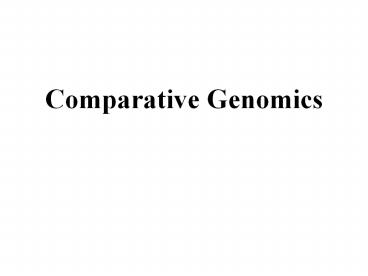Comparative Genomics - PowerPoint PPT Presentation
1 / 19
Title:
Comparative Genomics
Description:
Comparative Genomics What is Comparative Genomics? It is the comparison of one genome to another. Genomics DNA (Gene) Functional Genomics Transcriptomics RNA ... – PowerPoint PPT presentation
Number of Views:353
Avg rating:3.0/5.0
Title: Comparative Genomics
1
Comparative Genomics
2
What is Comparative Genomics?
It is the comparison of one genome to another.
3
How is it different from what weve already
covered and been doing in class?
4
How is it different from what weve already
covered and been doing in class?
When we BLAST a sequence is that comparative
genomics?
5
Difference is in Scale and Direction
Other omics
Comparative
One or several genes compared against all other
known genes.
Entire Genome compared to other entire genomes.
Use information from many genomes to learn more
about the individual genes.
Use genome to inform us about the entire organism.
6
What are some questions that comparative genomics
can address?
How has the organism evolved? What differentiates
species? Which non-coding regions are
important? Which genes are required for organisms
to survive in a certain environment?
7
Different Questions Require Different Comparisons
From Hardison. Plos Biology. Vol 1 (2) 156-160
8
From Miller et al. Annu. Rev. Genom. Human.
Genet. 2004.515-56.
9
Example of a Comparative Genomic Study Kellis
et al. 2003. Nature. 423241-254. Purpose of
the paper is to use the genomes of three closely
related Saccharomyces strains to inform our
knowledge about S. cerevisiae.
10
First step is to align the genomes as above.
Several webtools are available for genome
alignment and other comparative tasks. For some
go to http//www.dcode.org/
11
By comparing the genomes they not only found
numerous new regulatory motifs, but they were
able to reduce the total S.
cerevisiae gene estimate by 500.
The authors could have also focused their
comparisons on what parts of these similar
genomes account for each strains uniqueness
instead just focusing on gaining insights into S.
cerevisiae.
12
From http//www.macdevcenter.com/pub/a/mac/2004/0
6/29/bioinformatics.html
13
The Saccharomyces study could have also taken the
comparative approach to gain insights into the
functional similarities that defines the
organisms as relatives. Recently 5 Campylobacter
species genomes were sequenced, and analyzed to
determine what is the core genetic blueprint of
the genus (as well as differences between the
species).
14
From Fouts et al. 2005. PLoS Biology. 3(1)72-85.
15
Authors could have also taken a greater focus
onto how the Campylobacter species evolved (or
Saccharomyces). How each one evolved, and the
steps by which they diverged from a common
ancestor.
16
How did E. coli 0157H7 evolve?
From Wick et al. 2005. Journal of Bacteriology.
187 (5)
17
What about the other omics?
18
From Redfern et al. 2005. Journal of
Chromatography B. 81597-107
19
Downsides to the technique Genetic Drift - how
can we tell what differences are really selection
and important to organism function and not a
result of genetic drift? Computationally
intensive - large amounts of data that are being
compared, still coming up with the tools to
process and compare genomes. In order for the
comparisons to be statistically relevant many
more genomes will need to be sequenced.































